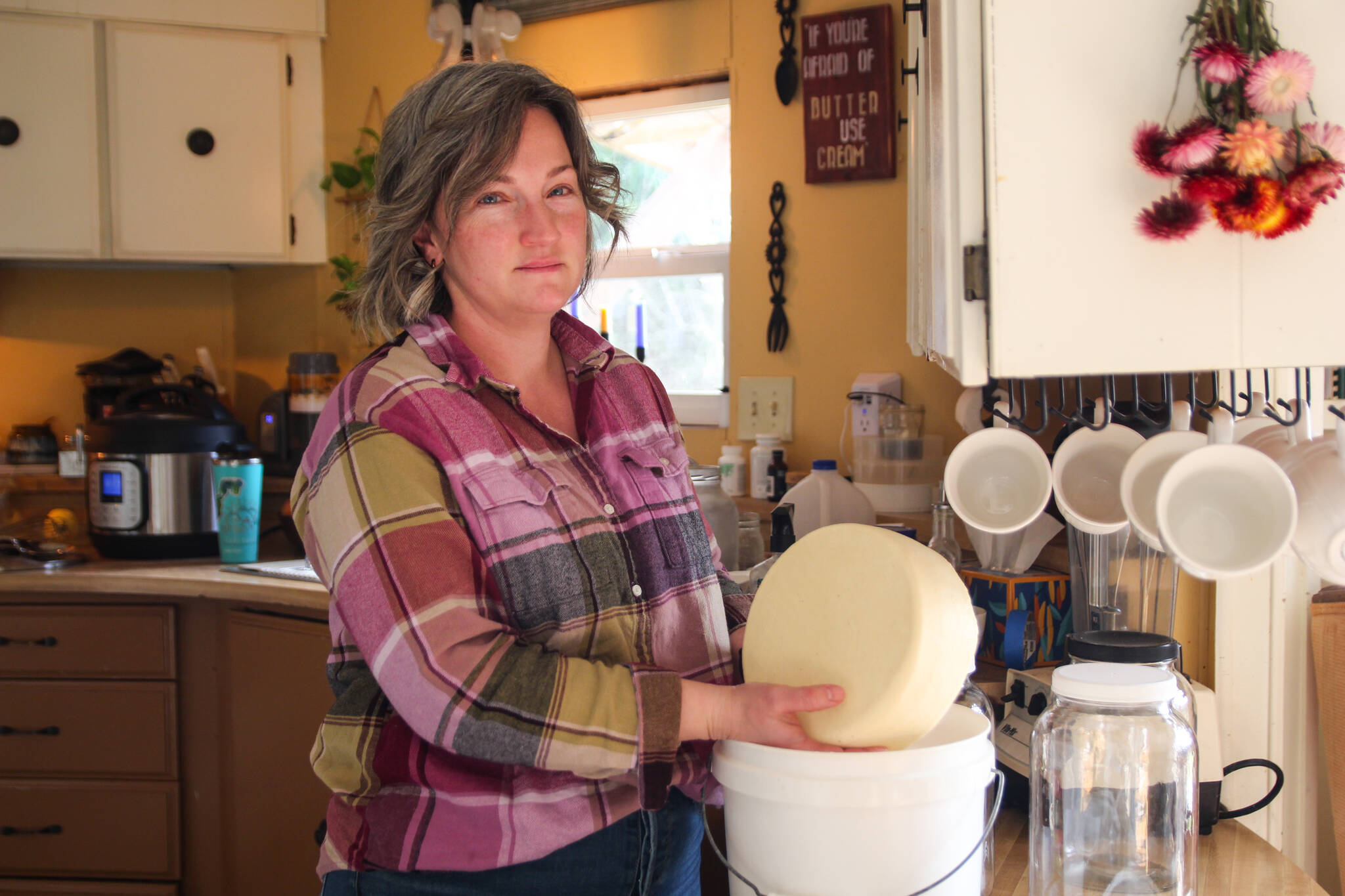Inside the quaint kitchen of Diana Joy Miller’s homestead, the silence was broken by the mews of spoiled kitties and the rhythmic sound of the metal whisk breaking through the curd as it slowly heated in a pot.
For the North Whidbey resident, Mondays are for cheesemaking, an activity that she finds both peaceful and necessary. With a single cow producing about six gallons of milk every day, she has to put it to good use somehow.
After three years of perfecting her hard cheese-making skills, Miller has been teaching cheesemaking classes to fellow dairy enthusiasts since last spring, with new sessions offered in February at the Coupeville Recreation Hall, located at 901 Northwest Alexander Street in Coupeville.
Miller was born and raised in an Amish community in Montana, where she learned the art of self-sufficiency. She then moved to Shaw Island with her husband Matt in 2002 before relocating to Whidbey Island in 2016, where she became a licensed midwife.
Now, she is taking a break from caring for women during childbirth, focusing instead on her family and the farm, where the Millers raise ducks, chickens and Jersey cows.
These cows, she said, produce fatty milk that is ideal for cheese and butter. Additionally, they are smaller and produce less milk than the black and white Holstein cows, making them a good choice for homestead settings.
When she first switched from making soft cheese from goats to hard cheese from her newly acquired cows, Miller looked forward to making Gouda, Swiss cheese and Parmesan, but felt intimidated by the seemingly daunting process.
However, she quickly realized it wasn’t rocket science, but rather a babysitting job and an exercise in patience.
On a sunny Monday afternoon, she decided to prepare an Alpine Tomme cheese, which takes about three to four hours to prepare before it’s ready to be pressed and stored. After she leaves the four-pound wheel to age for four to six months, the cheese can be served with crackers, tacos, turkey sandwiches, hamburgers and even as an alternative to mozzarella in a homemade pizza, she said.
After milking the cows in the morning, Miller strains the milk into a large pot to slowly heat it to 110 degrees — 20 degrees higher than its original temperature. She then adds two key ingredients in traditional cheesemaking: clabber culture and rennet.
The clabber culture is a raw milk starter culture that works similarly to a sourdough starter, as it needs to be “fed” once a day, while rennet is a set of enzymes that is sourced from the lining of a calf’s stomach and is used to coagulate milk and to separate the curd from the liquid whey.
Once the milk began to thicken into a curd, Miller dipped a metal whisk into the pot to cut the curd into smaller pieces, taking short breaks in between and occasionally feeling the texture of the curd, looking for a firm consistency and curds the size of a big lentil.
While only requiring some stirring, this process doesn’t allow for distractions like running errands, she said, hence she recommends setting plenty of time aside to tend to the cheese-to-be.
After a few hours, the curd was ready to meet the cheese press. While people can buy an expensive device, they can also opt to build their own, like Miller’s husband Matt did.
Once she poured the whey into a bucket, Miller poured the curds into a cloth, letting them drain before pressing them into a mold with the help of a wooden plate and a jar containing one gallon of water.
She then flipped the mold two or three times, letting it rest 30 minutes each time before letting it rest for 24 hours. The curds, now compacted into a pale cheese wheel weighing four pounds, would then be placed into an 18% salt brine for another 24 hours, turning into a yellowish color before drying in a cool room and being vacuum sealed, not to see a knife for another four to six months.
One of the aspects she likes most about cheesemaking is the delayed gratification. However, if she feels like eating a snack in the process, she can eat the curds, which are soft and mild in flavor.
The whey can be used in different ways. If poured back into the pot to heat it at a warmer temperature, it turns into ricotta. It could also be used to make a caramel sauce, another batch of cheese, or to mix with some honey and salt to make a probiotic drink, she said. Alternatively, the whey can be a healthy snack for chickens, pigs and plants.
Miller also makes butter and yogurt once a week, and is open to teaching how to make those as well, if people show interest.
She believes anybody who has access to a cow, goat or sheep should make their own dairy products. A cow, she estimated, can easily support five families.
On top of supporting local farmers, families would know exactly what’s in their food, resulting in healthier diets. Plus, the final result can be quite rewarding.
“You value something so much more when you’ve been a part of the process,” Miller said.
To book a class at the price of $100, visit Homestead Cheesemaking on Facebook to find the “Cheesemaking on the Homestead” Calendly link. For more information, contact Diana Miller at diamonddreamer8@gmail.com.



